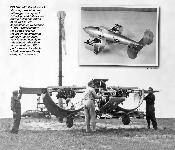
Фотографии
-
Aviation Historian 16 / N.Stroud - Willard Custer & the Channel Wing
Регистрационный номер: N1375V [5] President of Custer’s first company, the National Aircraft Corp, Frank D. Kelley sits at the controls of the startling CCW-2, Custer’s second full-size channel-wing aircraft, in 1948.
-
Aviation Historian 16 / N.Stroud - Willard Custer & the Channel Wing
Регистрационный номер: N1375V [5] Willard’s son Harold Custer at the controls of the CCW-2, built purely as an engineering testbed to conduct experiments with the channel wing. Based on the fuselage of a Taylorcraft lightplane, the CCW-2 is seen here without outer wing panels and with its original tricycle undercarriage, in which form it first flew in July 1948.
-
Aviation Historian 16 / N.Stroud - Willard Custer & the Channel Wing
Регистрационный номер: N1375V [5] With the windsock showing zero wind, the taildragger-configured CCW-2 pulls it tethers taut during a demonstration of its vertical-lift capabilities on December 7, 1951. Unfortunately for Custer, NACA’s testing of the aircraft at Langley the following year focused heavily on this aspect rather than its conventional STOL performance, for which it had been specifically designed.
-
Aviation Historian 16 / N.Stroud - Willard Custer & the Channel Wing
Регистрационный номер: N1375V [5] Willard Custer demonstrates the sucking effect of the pusher-configured propellers over the port channel of the as-yet-uncovered CCW-2 with a ribbon. When first reported in the UK, in the January 4, 1952, issue of Flight, the tenor of the article was mildly sceptical: “The claims made by the Custer Corporation are, to say the least, sweeping ..."
-
Aviation Historian 16 / N.Stroud - Willard Custer & the Channel Wing
Регистрационный номер: N1375V [5] The CCW-2, given the civil registration N1375V, mounted on a test stand in the windtunnel at NACA’s Langley Aeronautical Laboratory on May 8, 1952. By the time of the trials the diminutive CCW-2 had been modified with a taildragger undercarriage, the fuselage was covered and a small enclosed cockpit had been incorporated.




